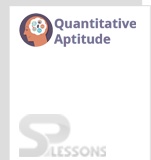 Introduction
Introduction
What is Quantitative Aptitude test?
Quantitative Aptitude is one of the prominent competitive aptitude subjects which evaluates numerical ability and problem solving skills of candidates. This test forms the major part of a number of important entrance and recruitment exams for different fields. The Quantitative Aptitude section primarily has questions related to the Simplification, Numbering Series, and Compound Interest, etc.
A candidate with quantitative aptitude knowledge will be in a better position to analyse and make sense of the given data. Quantitative Aptitude knowledge is an important measure for a prospective business executive's abilities.
The article SSC CPO Quantitative Aptitude Quiz 2 provides Quantitative Aptitude questions with answers useful to the candidates preparing for Competitive exams, Entrance exams, Interviews etc. The article SSC CPO Quantitative Aptitude Quiz 2 will assist the students to know the expected questions from Quantitative Aptitude.
 Quiz
Quiz
1. Shivam travels 20% distance of the total journey by car and 50% of the remaining by train and taxi in the respective ratio of 5:3 and the remaining distance he covers on feet. If the sum of the distance which he travels by car and by Taxi is 126 km, then find the total distance which Shivam travels during his journey?
- A. 360 km
B. 640 km
C. 420 km
D. 400 km
- A. 2.5 m/s
B. 3.33 m/s
C. 5 m/s
D. 6.66 m/s
- A. 38: 31
B. 33: 35
C. 35: 37
D. 13 : 47
- A. 5 hours
B. 3 hours
C. 6 hours
D. 8 hours
- A. 3.6 sec
B. 4 sec
C. 5.2 sec
D. 6.8 sec
1. The average weight of three friends Amar, Visera, and Daman is 70 kg. Another person Vishal joins the group and now the average is 66 kg. If another person Tahir whose weight is 6 kg more than Vishal, joins the group replacing Amar, then the average weight of Visera, Daman, Vishal, and Tahir becomes 75 kg. What is the weight of Amar (in kg)?
- A. 18
B. 20
C. 22
D. 24
- A. Rs. 4000
B. Rs. 3400
C. Rs. 3700
D. Rs. 3100
- A. 1557.87
B. 1558.20
C. 1558.92
D. 1559.51
- A. 22, 8
B. 29, 12
C. 18, 10
D. 13, 6
- A. 46 years
B. 37 years
C. 56 years
D. 42 years
1. The least number which when divided by 6, 9, 12, 15, 18 leaves the same remainder 2 in each case, is:
- A. 176
B. 178
C. 180
D. 182
- A. 1078
B. 1398
C. 1426
D. 1484
- A. 120
B. 150
C. 175
D. 270
- A. After 3000 days
B. After 2000 days
C. After 1500 days
D. After 1200 days
- A. 0.21 and 6.30
B. 1.05 and 6.30
C. 2.1 and 0.63
D. 0.63 and 1.05





